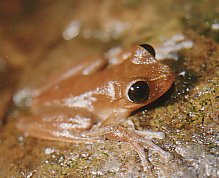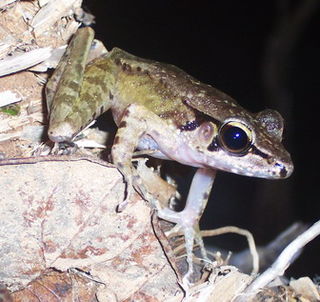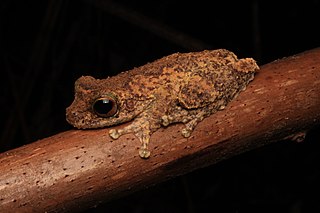
Ranoidea chloris, commonly known as the red-eyed tree frog or orange-eyed tree frog, is a species of tree frog native to eastern Australia; ranging from south of Sydney to Proserpine in mid-northern Queensland.

Taudactylus is a genus of frogs in the family Myobatrachidae. These frogs are endemic to rainforest areas of coastal eastern Australia, most of this genus inhabit fast flowing streams in highland area. Most members of this genus have suffered serious declines, in which the disease chytridiomycosis appears to have played a significant role: T. diurnus is believed to be extinct, while all others except T. liemi are listed as critically endangered by the IUCN. These listings are conservative, and it is likely T. acutirostris, presently listed as critically endangered, already is extinct.

The leaf green tree frog is a species of stream-dwelling frog, native to eastern Australia from the Queensland/New South Wales border south to Sydney.

The mountain stream tree frog is a species of tree frog native to highland areas of NSW, Australia stretching from the Myall Lakes area, north to around Dorrigo National Park and west to Barrington Tops National Park.

Pearson's green tree frog, also known as the cascade tree frog, is a species of tree frog inhabiting rainforest creeks from north of Lismore, New South Wales, to Kenilworth, Queensland, with a disjunct population at Kroombit Tops Queensland, Australia.

The dainty green tree frog, also known as the graceful tree frog, is a species of tree frog in the subfamily Pelodryadinae. It is native to eastern Queensland, and north-eastern New South Wales, Australia and ranges from northern Cape York in Queensland to Gosford in New South Wales, with a small and most likely introduced population in Hornsby Heights in Sydney. It is the faunal emblem of the City of Brisbane.

The peppered tree frog is a species of frog in the subfamily Pelodryadinae. It has a green back speckled with black, a cream-coloured belly and a dark stripe running from the shoulder. It is endemic to a very small area of the Northern Tablelands of New South Wales, Australia where it is known from five stream systems. It has not been observed in the wild since the 1970s, but a frog of very similar appearance has been observed in an area slightly further north, and it is not clear whether these are examples of the peppered tree frog or an outlying population of Pearson's green tree frog. The International Union for Conservation of Nature has assessed the peppered tree frog's conservation status as being "data deficient".

The striped burrowing frog is a species of burrowing frog in the subfamily Pelodryadinae of the family Hylidae. It occurs throughout much of Australia, from northern New South Wales, through eastern and northern Queensland and into eastern Northern Territory. This species was once included in the genus Litoria or Cyclorana.

The Australian lace-lid is a species of tree frog in the subfamily Pelodryadinae. It is endemic to the wet tropics of north-eastern Queensland, Australia.

The Booroolong frog is a species of stream-dwelling frog native to the Great Dividing Range in New South Wales, Australia. It is a member of the Hylidae, or the "tree frog" family. The Booroolong frog is classified by the IUCN as a Critically Endangered Species.

Amphibians of Australia are limited to members of the order Anura, commonly known as frogs. All Australian frogs are in the suborder Neobatrachia, also known as the modern frogs, which make up the largest proportion of extant frog species. About 230 of the 5,280 species of frog are native to Australia with 93% of them endemic. Compared with other continents, species diversity is low, and may be related to the climate of most of the Australian continent. There are two known invasive amphibians, the cane toad and the smooth newt.

The Eungella torrent frog or Eungella day frog is a species of stream dwelling frog endemic to Australia. It is restricted to ranges west of Mackay in mid-eastern Queensland.

The green-thighed frog is a species of tree frog in the subfamily Pelodryadinae. Members of this species are medium-sized, ground-dwelling frogs, and are found in Australia.

The common mist frog is a species of tree frog native to north-eastern Queensland, Australia. It is a medium-sized frog and a member of the Australian torrent treefrog group. The common mist frog is found in remote, mountainous areas, and near rocky, fast-flowing rainforest streams such as those in north-eastern Queensland, Australia. They are generally sedentary frogs, and remain in the stream environments that they are born into, preferring sections of the stream with riffles, many rocks, and overhanging vegetation.

The Australian waterfall frog or torrent treefrog is a species of tree frog native to Far North Queensland, Australia. The common name "waterfall frog" is indicative of its habitat of moist, rocky streams, and is often found along waterfalls within its range.

The green-eyed treefrog is a species of Australasian treefrog in the subfamily Pelodryadinae that occurs in the Wet Tropics of Australia.
The mountain mist frog or Nyakala frog was a species of frog in the subfamily Pelodryadinae, endemic to Australia. Its natural habitats were subtropical or tropical moist lowland forests and rivers. It was threatened by habitat loss and potentially chytrid fungus, before being declared extinct in 2022.
The Kroombit tinker frog, also sometimes referred to as Pleione's torrent frog, is a species of frog in the family Myobatrachidae. It is endemic to Central Queensland in Australia. It lives among rocks and leaf litter near small flowing streams.

Torrent frogs are a number of unrelated frogs that prefer to inhabit small rapid-flowing mountain or hill streams with a lot of torrents. They are generally smallish neobatrachians with a greyish-brown and usually darkly mottled back, giving them excellent camouflage among wet rocks overgrown with algae; their well-developed feet make them agile climbers of slippery rocks.

Ranoidea myola, commonly known as the Kuranda tree frog or Myola tree frog, is a critically endangered species of frog in the subfamily Pelodryadinae. It is endemic to the wet tropics of Australia.

















